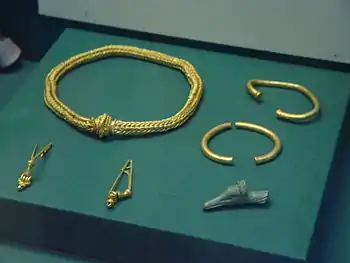Diplomatic gift
A diplomatic gift is a gift given by a diplomat, politician or leader when visiting a foreign country. Usually the gift is reciprocated by the host. The use of diplomatic gifts dates back to the ancient world and givers have competed to outdo each other in the lavishness of their gifts. Examples include silks given to the West by the Byzantines in the early Middle Ages,[2] the luxury book,[3] and panda diplomacy by the Chinese in the twentieth century.

The Middle Ages
In 757 Byzantine emperor Constantine V gave Pippin III of Francia a mechanical organ intended to indicate the superiority of Byzantine technology.[4]
Nineteenth century
After the Congress of Vienna (1814–15), Rundell, Bridge, and Rundell, goldsmiths to the British royal family and government, prepared 22 snuff-boxes to a value of 1000 guineas each to be given as diplomatic gifts.[5]
In the mid 19th century, the Chinese diplomat Qiying gifted intimate portraits of himself to representatives from Italy, Great Britain, the United States, and France as part of treaty negotiations with the West over control of land and trade in China after the First Opium War.[6]
Twentieth century
When he was the US Secretary of State, James Baker accepted a shotgun from the Foreign Minister of the Soviet Union, Eduard Shevardnadze.[7]
Missteps
Diplomatic gifts have the potential to seal international friendships, but also to be rebuffed, to seem mismatched, or to accidentally send the wrong message. Taiwan rejected the People's Republic of China's offer of a Panda.[8] A 2012 gift of a "British" table tennis table to President Obama seemed ideal until it was revealed that it was designed in Britain but made in China, evoking worries about the decline of British manufacturing industry.[9]
Gallery
Diplomatic gifts take diverse forms:
 Casket with Sinhalese and Christian imagery. A gift from the King of Kotte to the King of Portugal, c. 1557.
Casket with Sinhalese and Christian imagery. A gift from the King of Kotte to the King of Portugal, c. 1557. The Infanta Isabella Clara Eugenia, Archduchess of Austria, pictured together with her dwarf by Frans Pourbus the younger. A gift to James VI of Scotland, 1603.
The Infanta Isabella Clara Eugenia, Archduchess of Austria, pictured together with her dwarf by Frans Pourbus the younger. A gift to James VI of Scotland, 1603. Cohiba cigars were often used as diplomatic gifts by Fidel Castro's Cuba.
Cohiba cigars were often used as diplomatic gifts by Fidel Castro's Cuba._Commanding_Officer%252C_Capt._Jeffrey_M._Hughes%252C_exchange_gifts_during_a_reception_on_board_the_Emory_S._Land_to_celebrate_Montenegro's.jpg.webp) The Montenegro Minister of Defense and a U.S. Navy officer exchange gifts in 2007 during a reception to mark the first year of Montenegro's independence.
The Montenegro Minister of Defense and a U.S. Navy officer exchange gifts in 2007 during a reception to mark the first year of Montenegro's independence.
References
- Alberge, Dalya (8 September 2003). "Golden hoard of Winchester gives up its secret". The Times. Retrieved 2 August 2010.
- "Silken diplomacy" by Anna Muthesius in Shepard J. & Franklin, Simon. (Eds.) (1992) Byzantine Diplomacy: Papers from the Twenty-fourth Spring Symposium of Byzantine Studies, Cambridge, March 1990. Aldershot: Variorum, pp. 236–248. ISBN 0860783383
- "The luxury book as diplomatic gift" by John Lowden in Shepard J. & Franklin, Simon. (Eds.) (1992) Byzantine Diplomacy: Papers from the Twenty-fourth Spring Symposium of Byzantine Studies, Cambridge, March 1990. Aldershot: Variorum, pp. 249–260.
- Wickham, Chris. (2010) The inheritance of Rome: A history of Europe from 400 to 1000. London: Penguin Books, p. 228. ISBN 9780140290141
- Marcia Pointon, "Surrounded with brilliants: Miniature portraits in eighteenth century England", The Art Bulletin, Vol. 83, No. 1, (March 2001), pp. 48–71.
- Koon, Yeewan (2012). "The Face of Diplomacy in 19th-Century China: Qiying's Portrait Gifts". In Johnson, Kendall (ed.). Narratives of Free Trade: The Commercial Cultures of Early US-China Relations. Hong Kong University Press. pp. 131–148.
- James A. Baker III, The Politics of Diplomacy: Revolution, War and Peace, 1989–1992 (New York: G. P. Putnam's Sons, 1993)
- We're not wild about your pandas, China told by Richard Spencer, The Daily Telegraph, 24 March 2006. Retrieved 17 February 2014.
- David Cameron's table tennis table gift to Barack Obama made in China by James Orr, The Telegraph, 18 March 2012. Retrieved 17 February 2014.
Further reading
- Jacoby, D. "Silk economics and cross-cultural artistic interaction: Byzantium, the Muslim World, and the Christian West", Dumbarton Oaks Papers 58 (2004:197–240).
External links
 Media related to Diplomatic gifts at Wikimedia Commons
Media related to Diplomatic gifts at Wikimedia Commons